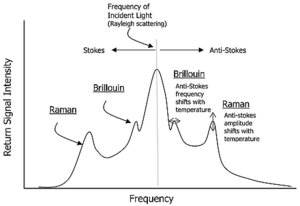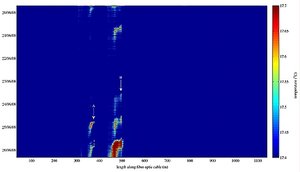Distributed Temperature Sensing
Temperature is an interesting tracer that is used for many different hydrological and hydraulic measurements. In distributed temperature sensing (DTS), a single fiber optic cable measures temperature at thousands of points. DTS was developed in the petro-chemical industry to monitor for example oil wells. Our group found its application also possible in environmental sensing. Ever since, the possible applications appeared numerous.
How does it work?
DTS allows the instantaneous measurement of temperature along an optical fibre: every second, every meter, for kilometers of cable.
This is possible because of a laser pulse that is emitted into the fiber-optic cable and is partly scattered back all along the cable. Apart from returning with the frequency of the incident laser pulse, the backscattered signal is partly shifted towards both higher (anti-Stokes) and lower (Stokes) frequencies. Changes in amplitude (Raman) or frequency (Brillouin) at the anti-Stokes frequencies are temperature dependent, whereas those at the Stokes frequencies are not (see Fig. 1). One can do this for many points along the cable since the position of each point can be determined from the travel time of the signal.

Fig. 1: Frequency bands of the backscattered signal: the anti-Stokes bands are temperature dependent whereas the Stokes bands are not (Selker et al., Water Resources Research, 2006).
Instruments
Currently, our section uses four DTS instruments: the Silixa Ultima, the Sensornet Oryx and the Sensornet Halo (2x).
Specifications:
|
|
Applications
We used DTS amongst others to:
- find illicit connections in sewer systems (see Fig. 2);
- measure heat fluxes in 2D around small streams;
- find and measure sources of upwelling ground water in polder systems;
- measure heat fluxes into and out of the top layer of soil to derive soil moisture content;
- measure evaporation fluxes according to the Bowen ratio.

Fig. 2: Detection of illicit sewer connections: the warmer spots show the discharge of foul water into a storm water sewer on two locations along the fiber-optic cable in the sewer (Hoes et al., Water Research, 2009).
Related projects
- Soil moisture estimation using Distributed Temperature Sensing
- Modeling the heat storage and estimating evaporation of lakes and reservoirs in arid and semi-arid regions
- Monitoring and modelling salt water intrusion in deltas
- Droughts and land-atmosphere feedbacks
Completed projects
- High resolution temperature observations to identify different runoff processes
- Operationalization of SoilDTS
- Urban Surface water as energy source